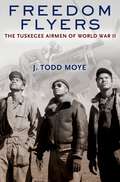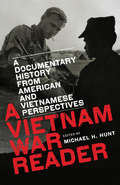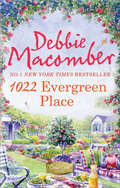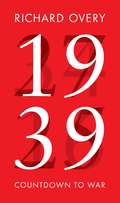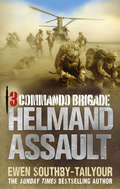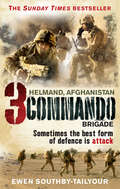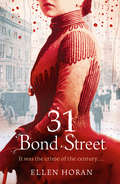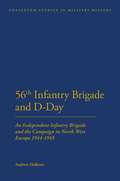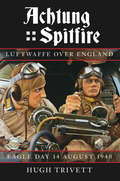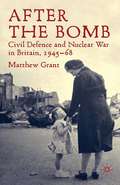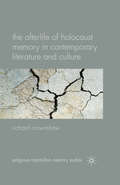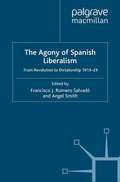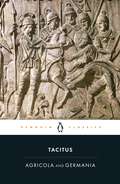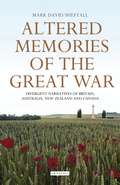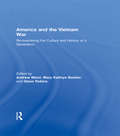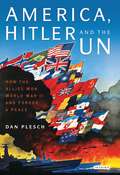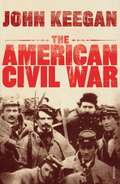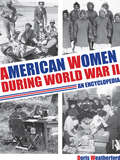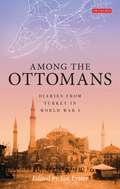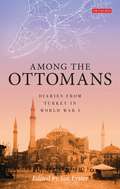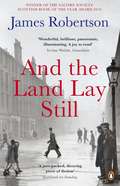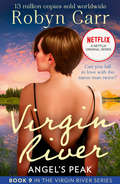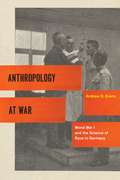- Table View
- List View
Freedom Flyers: The Tuskegee Airmen of World War II (Oxford Oral History Series)
by J. Todd MoyeAs the country's first African American military pilots, the Tuskegee Airmen fought in World War II on two fronts: against the Axis powers in the skies over Europe and against Jim Crow racism and segregation at home. Although the pilots flew more than 15,000 sorties and destroyed more than 200 German aircraft, their most far-reaching achievement defies quantification: delivering a powerful blow to racial inequality and discrimination in American life. In this inspiring account of the Tuskegee Airmen, historian J. Todd Moye captures the challenges and triumphs of these brave pilots in their own words, drawing on more than 800 interviews recorded for the National Park Service's Tuskegee Airmen Oral History Project. Denied the right to fully participate in the U.S. war effort alongside whites at the beginning of World War II, African Americans--spurred on by black newspapers and civil rights organizations such as the NAACP--compelled the prestigious Army Air Corps to open its training programs to black pilots, despite the objections of its top generals. Thousands of young men came from every part of the country to Tuskegee, Alabama, in the heart of the segregated South, to enter the program, which expanded in 1943 to train multi-engine bomber pilots in addition to fighter pilots. By the end of the war, Tuskegee Airfield had become a small city populated by black mechanics, parachute packers, doctors, and nurses. Together, they helped prove that racial segregation of the fighting forces was so inefficient as to be counterproductive to the nation's defense. Freedom Flyers brings to life the legacy of a determined, visionary cadre of African American airmen who proved their capabilities and patriotism beyond question, transformed the armed forces--formerly the nation's most racially polarized institution--and jump-started the modern struggle for racial equality.
A Vietnam War Reader: A Documentary History from American and Vietnamese Perspectives
by Michael H. HuntAn essential new resource for students and teachers of the Vietnam War, this concise collection of primary sources opens a valuable window on an extraordinarily complex conflict. The materials gathered here, from both the American and Vietnamese sides, remind readers that the conflict touched the lives of many people in a wide range of social and political situations and spanned a good deal more time than the decade of direct U.S. combat. Indeed, the U.S. war was but one phase in a string of conflicts that varied significantly in character and geography. Michael Hunt brings together the views of the conflict's disparate players--from Communist leaders, Vietnamese peasants, Saigon loyalists, and North Vietnamese soldiers to U.S. policymakers, soldiers, and critics of the war. By allowing the participants to speak, this volume encourages readers to formulate their own historically grounded understanding of a still controversial struggle.
1022 Evergreen Place (A Cedar Cove Novel #10)
by Debbie MacomberPerfect for fans of Maeve Binchy' - Candis Dear Reader, Guess what? I'm falling in love! With Mack McAfee.
1939: Countdown to War
by Richard Overy24 August 1939: The fate of the world is hanging in the balance. Hitler has ambitions to invade Poland and hopes Stalin will now help him. And the West must try to stop him. If they don't, world war will result.In this dramatic account of the last days of peace in 1939, Richard Overy re-creates hour by hour the unfolding story in the capitals of Europe as politicians and the public braced themselves for a war that they feared might spell the end of European civilisation. There was nothing entirely predictable or inevitable about the outcome. The West hoped that Hitler would see sense if they stood firm. Hitler was convinced the West would back down. There were moments of hesitation and moments of confrontation; secret intelligence was used by both sides to support their hopes. The one constant feature was the determination of Poland, a country created only in 1919, to fight a war that seemed entirely irrational, against the armed might of Germany. Countdown to War brings to life a defining moment in the history of the violent twentieth century.
3 Commando: Helmand Assault
by Ewen Southby-TailyourWhen the Royal Marines Commandos returned to a chaotic Helmand in the winter of 2008, they realised that to stand any chance of success they would need to pursue an increasingly determined Taliban harder than ever before. This time they were going to hunt them down from the air. With the support of Chinooks, Apaches, Lynx, Sea Kings and Harriers, the Commandos became a deadly mobile unit, able to swoop at a moments notice into the most hostile territory.From huge operations like the gruelling Red Dagger, when 3 Commando Brigade fought in Somme-like mud to successfully clear the area around the capital of Helmand, Lashkar Gar, of encroaching enemy forces, to the daily acts of unsupported, close-quarters 360-degree combat and the breath-taking, rapid helicopter night assaults behind enemy lines - this was kind of battle that brought Commando qualities to the fore. As with the Sunday Times bestselling 3 Commando Brigade, ex-Marine Lieutenant Colonel Ewen Southby-Tailyour brings unparalleled access to the troops, a soldier's understanding of the conflict and a visceral sense of the combat experience. This is the real war in Afghanistan as told to him by a hand-picked band of young fellow marines as they encounter the daily rigours of life on the ground in the world's most intense war zone.
3 Commando Brigade: Helmand Assault
by Ewen Southby-Tailyour'The 3 Commando Brigade's six month deployment in Helmand Province was among the finest pieces of soldiering I have come across' General Sir Richard Dannett, Chief of General StaffIn October 2006, the Royal Marine Commandos took up their six month tour of duty in war-torn Helmand Province, southern Afghanistan - the toughest and hottest war zone on earth. After the tactical retreat of their predecessors, the Paras, the Marines knew they would have to take a different approach to have any chance of success. So they took the war to the enemy. Roving and aggressive, the Commandos forced the insurgent Taliban on to the back foot. As a result, they were involved in daily fire fights of an intensity not encountered by British troops since North Korea.3 Commando Brigade is a thrilling first-hand account of that dogged, heroic pursuit of the Taliban by the ordinary Marines, sailors and soldiers responsible. It is a story of valour, fortitude, supreme physical and mental fitness, and unrivalled professionalism under the most testing of circumstances. The account explodes from the first page with Operation Glacier, a graphic, no-holds-barred account of a Commando attack on a key Taliban base south of Garmsir - a battle that ends with the dramatic recovery of a Corporal's body from alongside the fort by Apache helicopters. From this opening salvo the action never lets up, offering a startlingly honest account of the war in Afghanistan as told by the junior officers, corporals and marines on the ground.
31 Bond Street: A Novel
by Ellen HoranBased on a true story, mystery and intrigue in pre-Civil War New York
56th Infantry Brigade and D-Day: An Independent Infantry Brigade and the Campaign in North West Europe 1944-1945 (Bloomsbury Studies in Military History)
by Andrew HolbornTrained as an assault brigade, the 56th landed on D-Day and successfully liberated Bayeux the following day. It was then employed in the crossing of the River Seine and the assault on Le Havre, before fighting across Belgium and Holland culminating in the final assault on Arnhem in April 1945, by which time the brigade had served in four different divisions. No previous study has sought to explain how an infantry brigade is used in battle, let alone one holding the title 'Independent'. Holborn considers the styles of war as carried out by British forces and casts new light on the effectiveness of British infantry units and their contribution to war effort. Extensive use has been made of new primary evidence from The National Archives, Imperial War Museum Archive and Regimental Museums. The evidence is used to explore issues pertinent to life in the Army at home during the war, training for war and the Campaign in North West Europe, as well as the role of the battalion.
Achtung Spitfire: Eagle Day 14 August 1940
by Hugh Trivett14 August 1940, which Hitler code-named ‘Adlertag’, or ‘Eagle Day’, was fated to become one of the most significant days in the Battle of Britain. It signified the start of the Luftwaffe’s aerial offensive, planned to cripple Britain and clear the path for the German troops ammased in readiness for invasion. The Luftwaffe sent out waves of unescorted bombers to attack difficult and long-range targets by daylight, hoping to confuse and split the fighter defences with the small but numerous bomb formations. The tactic was a calculated gamble and one that cost the Germans deeply. Despite successes in attacking and damaging airfields, the losses were severe and and the following day Goering vetoed such tactics, now convinced his bombers could never operate over Britain without fighter cover. Using first-hand recollections of both Luftwaffe and RAF pilots as well as local witnesses to the day’s action, gleaned from interviews and written accounts and with many unpublished photographs, Hugh Trivett has collated the definitive record of Eagle Day.
After The Bomb: Civil Defence and Nuclear War in Britain, 1945-68
by M. GrantCivil defence was an integral part of Britain's modern history. Throughout the cold war it was a central response of the British Government to the threat of war. This book will be the first history of the preparations to fight a nuclear war taken in Britain between the end of the Second World War and 1968.
The Afterlife of Holocaust Memory in Contemporary Literature and Culture (Palgrave Macmillan Memory Studies)
by R. CrownshawThis bold intervention into the debate over the memory and 'post-memory' of the Holocaust both scrutinizes recent academic theories of post-Holocaust trauma and provides a new reading of literary and architectural memory texts related to the Holocaust.
The Agony of Spanish Liberalism: From Revolution to Dictatorship 1913–23
by Francisco J. Romero SalvadóIt was during the period 1913-1923 that the seeds of political polarization and social violence culminating in the Spanish Civil War were sown. This volume explores the causes of the growing schism within Spanish society, focusing on the crisis of the Spanish liberal order, under challenge from newly mobilized forces on both the Right and Left.
Agricola and Germania: Edited On The Basis Of Draeger's Agricola And Schweizer-didler's Germania (Penguin Classics Series)
by Tacitus H. MattinglyThe Agricola is both a portrait of Julius Agricola - the most famous governor of Roman Britain and Tacitus' well-loved and respected father-in-law - and the first detailed account of Britain that has come down to us. It offers fascinating descriptions of the geography, climate and peoples of the country, and a succinct account of the early stages of the Roman occupation, nearly fatally undermined by Boudicca's revolt in AD 61 but consolidated by campaigns that took Agricola as far as Anglesey and northern Scotland. The warlike German tribes are the focus of Tacitus' attention in the Germania, which, like the Agricola, often compares the behaviour of 'barbarian' peoples favourably with the decadence and corruption of Imperial Rome.
Altered Memories of the Great War: Divergent Narratives of Britain, Australia, New Zealand and Canada (International Library of War Studies)
by Mark David SheftallThe experiences of World War I touched the lives of a generation but memories of this momentous experience vary enormously throughout the world. In Britain, there was a strong reaction against militarism but in the Dominion powers of Canada, Australia and New Zealand the response was very different. For these former colonial powers, the experience of war was largely accepted as a national rite of passage and their pride and respect for their soldiers' sacrifices found its focus in a powerful nationalist drive. How did a single, supposedly shared experience provoke such contrasting reactions? What does it reveal about earlier, pre-existing ideas of national identity? And how did the memory of war influence later ideas of self-determination and nationhood?Altered Memories of the Great War is the first book to compare the distinctive collective narratives that emerged within Britain and the Dominions in response to World War I. Britain, Canada, Australia and New Zealand endured equally grim experiences on the battlefield and all experienced major social upheaval as a result of the war. So why did Canadians, Australians and New Zealanders typically reject the more bitter representations of the war that so many people in Great Britain found compelling? During the inter-war years, men and women throughout the Empire struggled to come to terms with the huge losses of the Great War. Mark Sheftall explores how different communities re-imagined the experiences of war to form a collective memory which reflected the dominant opinion, although clearly not every individual conformed to the same views. This collective memory, he argues, can only be understood by exploring how new responses to the unprecedented experience of the conflict were shaped by long-standing conceptions of identity. Altered Memories of the Great War powerfully illuminates the differences as well as the similarities between different memories of war and offers fascinating insights into what this reveals about developing concepts of national identity in the aftermath of World War I.
America and the Vietnam War: Re-examining the Culture and History of a Generation
by Andrew Wiest Mary Kathryn Barbier Glenn RobinsThe Vietnam War was one of the most heavily documented conflicts of the twentieth century. Although the events themselves recede further into history every year, the political and cultural changes the war brought about continue to resonate, even as a new generation of Americans grapples with its own divisive conflict. America and the Vietnam War: Re-examining the Culture and History of a Generation reconsiders the social and cultural aspects of the conflict that helped to fundamentally change the nation. With chapters written by subject area specialists, America and the Vietnam War takes on subjects such as women’s role in the war, the music and the films of the time, the Vietnamese perspective, race and the war, and veterans and post-traumatic stress disorder. Features include: chapter summaries timelines discussion questions guides to further reading a companion website with primary source documents and tools (such as music and movie playlists) for both instructors and students. Heavily illustrated and welcoming to students and scholars of this infamous and pivotal time, America and the Vietnam War is a perfect companion to any course on the Vietnam War Era.
America and the Vietnam War: Re-examining the Culture and History of a Generation
by Andrew Wiest Mary Kathryn Barbier Glenn RobinsThe Vietnam War was one of the most heavily documented conflicts of the twentieth century. Although the events themselves recede further into history every year, the political and cultural changes the war brought about continue to resonate, even as a new generation of Americans grapples with its own divisive conflict. America and the Vietnam War: Re-examining the Culture and History of a Generation reconsiders the social and cultural aspects of the conflict that helped to fundamentally change the nation. With chapters written by subject area specialists, America and the Vietnam War takes on subjects such as women’s role in the war, the music and the films of the time, the Vietnamese perspective, race and the war, and veterans and post-traumatic stress disorder. Features include: chapter summaries timelines discussion questions guides to further reading a companion website with primary source documents and tools (such as music and movie playlists) for both instructors and students. Heavily illustrated and welcoming to students and scholars of this infamous and pivotal time, America and the Vietnam War is a perfect companion to any course on the Vietnam War Era.
America, Hitler and the UN: How the Allies Won World War II and Forged a Peace
by Dan PleschIn January 1942, the Declaration by United Nations forged a military alliance based on human rights principles that included over 24 countries, marking the beginning of the UN. But how did the armies of the United Nations co-operate during World War II to halt Nazi expansionism? When did the UN start to tackle the international economic and social challenges of the post-war world? This is the first book to explore how the profound restructuring of the international world order was organized. Drawing on previously unknown archival material, Plesch analyzes the engagement with the UN by all levels of society, from grassroots to the political elites. Plesch has pieced together the full story of how the UN intervened in surprising ways at a pivotal time in world history and argues that the UN s success is as vital today as it was then."
The American Civil War: A Military History (Vintage Civil War Library)
by John KeeganThe American Civil War was one of the longest and bloodiest of modern wars. It is also one of the most mysterious. It has captured the imagination of writers, artists and film-makers for decades but the reality of it confuses and divides historians even today. In this magisterial history of the first modern war, the distinguished military historian John Keegan unpicks the geography, leadership and strategic logic of the war and takes us to the heart of the conflict. His captivating work promises to be the definitive history of the American Civil War.
American Women during World War II: An Encyclopedia
by Doris WeatherfordAmerican Women during World War II documents the lives and stories of women who contributed directly to the war effort via official and semi-official military organizations, as well as the millions of women who worked in civilian defense industries, ranging from aircraft maintenance to munitions manufacturing and much more. It also illuminates how the war changed the lives of women in more traditional home front roles. All women had to cope with rationing of basic household goods, and most women volunteered in war-related programs. Other entries discuss institutional change, as the war affected every aspect of life, including as schools, hospitals, and even religion. American Women during World War II provides a handy one-volume collection of information and images suitable for any public or professional library.
American Women during World War II: An Encyclopedia
by Doris WeatherfordAmerican Women during World War II documents the lives and stories of women who contributed directly to the war effort via official and semi-official military organizations, as well as the millions of women who worked in civilian defense industries, ranging from aircraft maintenance to munitions manufacturing and much more. It also illuminates how the war changed the lives of women in more traditional home front roles. All women had to cope with rationing of basic household goods, and most women volunteered in war-related programs. Other entries discuss institutional change, as the war affected every aspect of life, including as schools, hospitals, and even religion. American Women during World War II provides a handy one-volume collection of information and images suitable for any public or professional library.
Among the Ottomans: Diaries from Turkey in World War I
by Ian LysterDuring World War One, the Ottoman Empire, one of the largest and longest-lasting empires in history, faced severe challenges to its structure and existence, which eventually resulted in its dissolution. 'Among The Ottomans' introduces two unique diary accounts written by two generations of the same family in the declining years of the Ottoman Empire.Written in the heart of the crumbling Ottoman Empire, Marie Lyster's World War One diaries describe the political and social climate of Constantinople as Allied troops swept through Turkey, wreaking havoc on the country's infrastructure and forcing residents, regardless of their national affiliations, to endure the hardships of war. Just 200 miles away in the Dardanelles, her son Henry was fighting with the Allies against the Turks. Following the Allied retreat in 1915, he was posted to Salonika in northern Greece, where he worked with the 'Comitajis' as they fought the Bulgarians. Later, as the Military Governor of Eastern Thrace, he witnessed the rise of Turkish Nationalism and the struggle for control of the fragmented pieces of the fallen empire. Published for the first time, these two diaries provide an unprecedented account of the Great War's impact across generations and geographical borders and a unique insight into the final years of the Ottoman Empire.
Among the Ottomans: Diaries from Turkey in World War I
by Ian LysterDuring World War One, the Ottoman Empire, one of the largest and longest-lasting empires in history, faced severe challenges to its structure and existence, which eventually resulted in its dissolution. "Among The Ottomans" introduces two unique diary accounts written by two generations of the same family in the declining years of the Ottoman Empire. Written in the heart of the crumbling Ottoman Empire, Marie Lyster's World War One diaries describe the political and social climate of Constantinople as Allied troops swept through Turkey, wreaking havoc on the country's infrastructure and forcing residents, regardless of their national affiliations, to endure the hardships of war. Just 200 miles away in the Dardanelles, her son Henry was fighting with the Allies against the Turks. Following the Allied retreat in 1915, he was posted to Salonika in northern Greece, where he worked with the 'Comitajis' as they fought the Bulgarians. Later, as the Military Governor of Eastern Thrace, he witnessed the rise of Turkish Nationalism and the struggle for control of the fragmented pieces of the fallen empire.Published for the first time, these two diaries provide an unprecedented account of the Great War's impact across generations and geographical borders and a unique insight into the final years of the Ottoman Empire.
And the Land Lay Still
by James RobertsonAnd the Land Lay Still is the sweeping Scottish epic by James RobertsonAnd the Land Lay Still is nothing less than the story of a nation. James Robertson's breathtaking novel is a portrait of modern Scotland as seen through the eyes of natives and immigrants, journalists and politicians, drop-outs and spooks, all trying to make their way through a country in the throes of great and rapid change. It is a moving, sweeping story of family, friendship, struggle and hope - epic in every sense.The winner of the Saltire Society Scottish Book of the Year Award 2010, And the Land Lay Still is a masterful insight into Scotland's history in the twentieth century and a moving, beautifully written novel of intertwined stories.'Toweringly ambitious, virtually flawlessly realized, a masterpiece and, without a doubt, my book of the year' Daily Mail'A jam-packed, dizzying piece of fiction' Scotland on Sunday'Gripping, vivid, beautifully realized' The Times'Engrossing' Daily Telegraph'Powerful and moving. A brilliant and multifaceted saga of Scottish life in the second half of the twentieth century' Sunday Times'Brilliant and thoughtful. Eminently readable, subtle and profound' Independent on Sunday'Bold, discursive and deep, Robertson's sweeping history of life and politics in 20th-century Scotland should not be ignored' Ian Rankin, Observer Books of the YearJames Robertson is the author of three previous novels: The Fanatic, Joseph Knight and The Testament of Gideon Mack, which is available in Penguin. Joseph Knight was awarded the two major Scottish literary awards in 2003/4 - the Saltire Book of the Year and the Scottish Arts Council Book of the Year - and The Testament of Gideon Mack was longlisted for the Man Booker Prize, picked by Richard and Judy's Book Club, and shortlisted for the Saltire Book of the Year award.
Angel's Peak: Forbidden Falls Angel's Peak Moonlight Road Midnight Confessions (A Virgin River Novel #9)
by Robyn CarrVirgin River – now a Netflix Original series Virgin River – Book 9 Can they overcome their past to look to the future
Anthropology at War: World War I and the Science of Race in Germany
by Andrew D. EvansBetween 1914 and 1918, German anthropologists conducted their work in the midst of full-scale war. The discipline was relatively new in German academia when World War I broke out, and, as Andrew D. Evans reveals in this illuminating book, its development was profoundly altered by the conflict. As the war shaped the institutional, ideological, and physical environment for anthropological work, the discipline turned its back on its liberal roots and became a nationalist endeavor primarily concerned with scientific studies of race. Combining intellectual and cultural history with the history of science, Anthropology at War examines both the origins and consequences of this shift. Evans locates its roots in the decision to allow scientists access to prisoner-of-war camps, which prompted them to focus their research on racial studies of the captives. Caught up in wartime nationalism, a new generation of anthropologists began to portray the country’s political enemies as racially different. After the war ended, the importance placed on racial conceptions and categories persisted, paving the way for the politicization of scientific inquiry in the years of the ascendancy of National Socialism.
